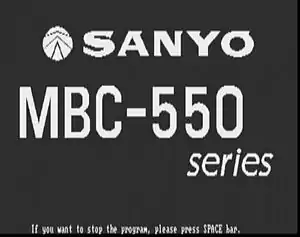MBC-550
The Sanyo MBC-550 is a small and inexpensive personal computer in "pizza-box" style, featuring an Intel 8088 microprocessor and running a version of MS-DOS. Sold by Sanyo, it was the least expensive early IBM PC compatible.[1]
 Original Sanyo MBC-550 demo written in BASIC at 27-9-1983. See full sourcecode of the demo | |
| Developer | Sanyo |
|---|---|
| Type | Personal computer |
| Release date | 1982 |
| Lifespan | 6 Years |
| Introductory price | <$1000 |
| Discontinued | 1988 |
| Units sold | 10,000+ |
| Operating system | MS-DOS |
| CPU | Intel 8088 at 3.58 MHz |
| Memory | 128 KB |
| Display | RGB Color Monitor CRT 70 |
| Graphics | RGB graphics adapter |
| Input | keyboard |
| Connectivity | 1 parallel port |
| Power | 120 V AC (North American model) |
| Dimensions | 380 x 112 x 360 mm |

The MBC-550 has much better video display possibilities than the CGA card (8 colors at 640x200 resolution, vs CGA's 4 colors at 320x200 or 2 colors at 640x200), but it is not completely compatible with the IBM-PC. The computer lacks a standard BIOS, having only a minimal bootloader in ROM that accesses hardware directly to load a RAM-based BIOS.[2] The diskette format (FM rather than MFM) used is not completely compatible with the IBM PC, but special software on an original PC or PC/XT (but not PC/AT) can read and write the diskettes, and software expecting a standard 18.2 Hz clock interrupt has to be rewritten.
The MBC-550 was also the computer for NRI training. Starting by building the computer, the NRI promised you would be "qualified to service and repair virtually every major brand of computer".[3] NRI advertised in Popular Mechanics and Popular Science throughout 1985.[4]
The MBC-550 is less PC compatible than the IBM PCjr. Its inability to use much PC software was a significant disadvantage; [1] InfoWorld reported in August 1985 that Sanyo "has initiated a campaign to sell off" of MBC-550 inventory. The company's newer computers were, an executive claimed, 99% PC compatible.[5]
Soft Sector Magazine
SOFT SECTOR was a magazine for people who owned Sanyo MBC-550 and 555 DOS computers. (But much of the content equally applied to most IBM clones at the time.) A typical issue includes news, reviews, how-to's, technical advice and education, tips and tricks, as well as BASIC language programs that you could copy from the printed page, and adapt to suit your needs.[6]
Models
- MBC-550 : 1 x 5.25" disk drive (160 KB)[7]
- MBC-555 : 2 x 5.25" disk drive (160 KB)
- MBC-555-2 : 2 x 5.25" disk drive (360 KB)
- MBC-555-3 : 2 x 5.25" disk drive (720 KB)
References
- Jon Geist (September 1984). "Sanyo 555 Small Business Computers". Creative Computing. Vol. 10 no. 9. p. 12.
- Elliott, John C. (2006-04-30). "The Sanyo MBC550". Seasip.info. Retrieved 2017-11-09.
- Corporation, Bonnier (1 March 1985). "Popular Science". 226 (3). Bonnier Corporation. Retrieved 25 July 2016. Cite journal requires
|journal=(help) - Magazines, Hearst (1 February 1985). "Popular Mechanics". Hearst Magazines. Retrieved 25 July 2016. Cite journal requires
|journal=(help) - Bannister, Hank (1985-08-26). "Sanyo Clears Deck of 550s". InfoWorld. p. 28. Retrieved 5 January 2015.
- "OLD-COMPUTERS.COM : The Museum". www.old-computers.com. Retrieved 2021-01-20.
- "OLD-COMPUTERS.COM : The Museum". www.old-computers.com. Retrieved 25 July 2016.
